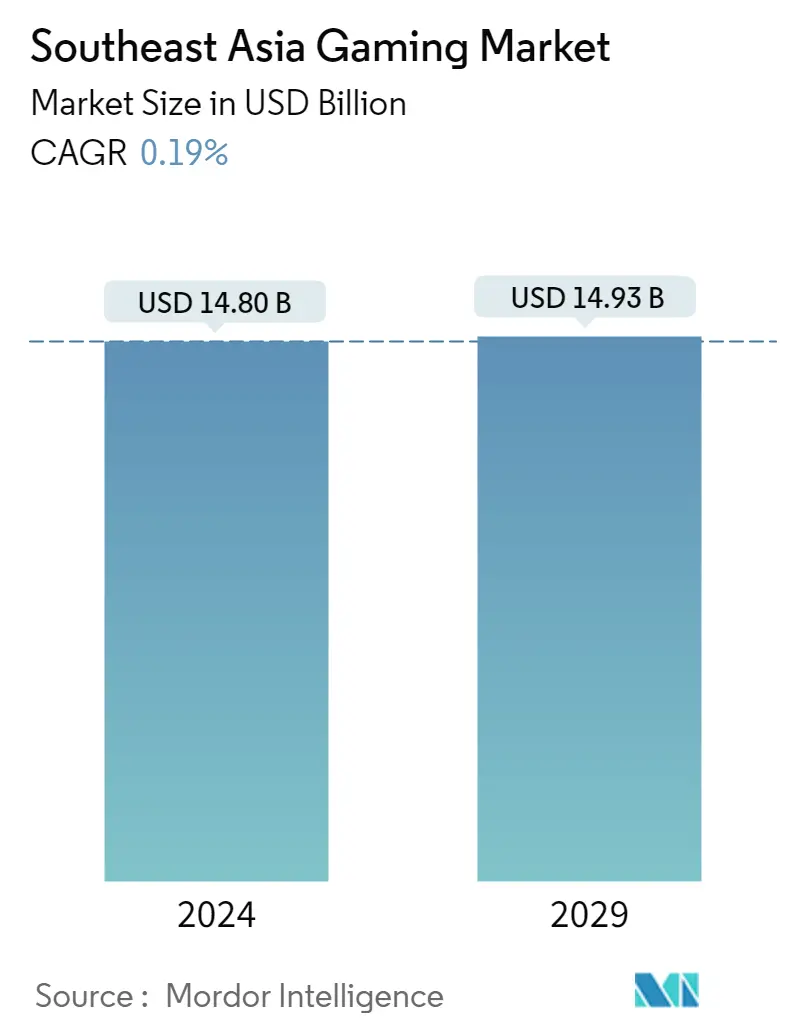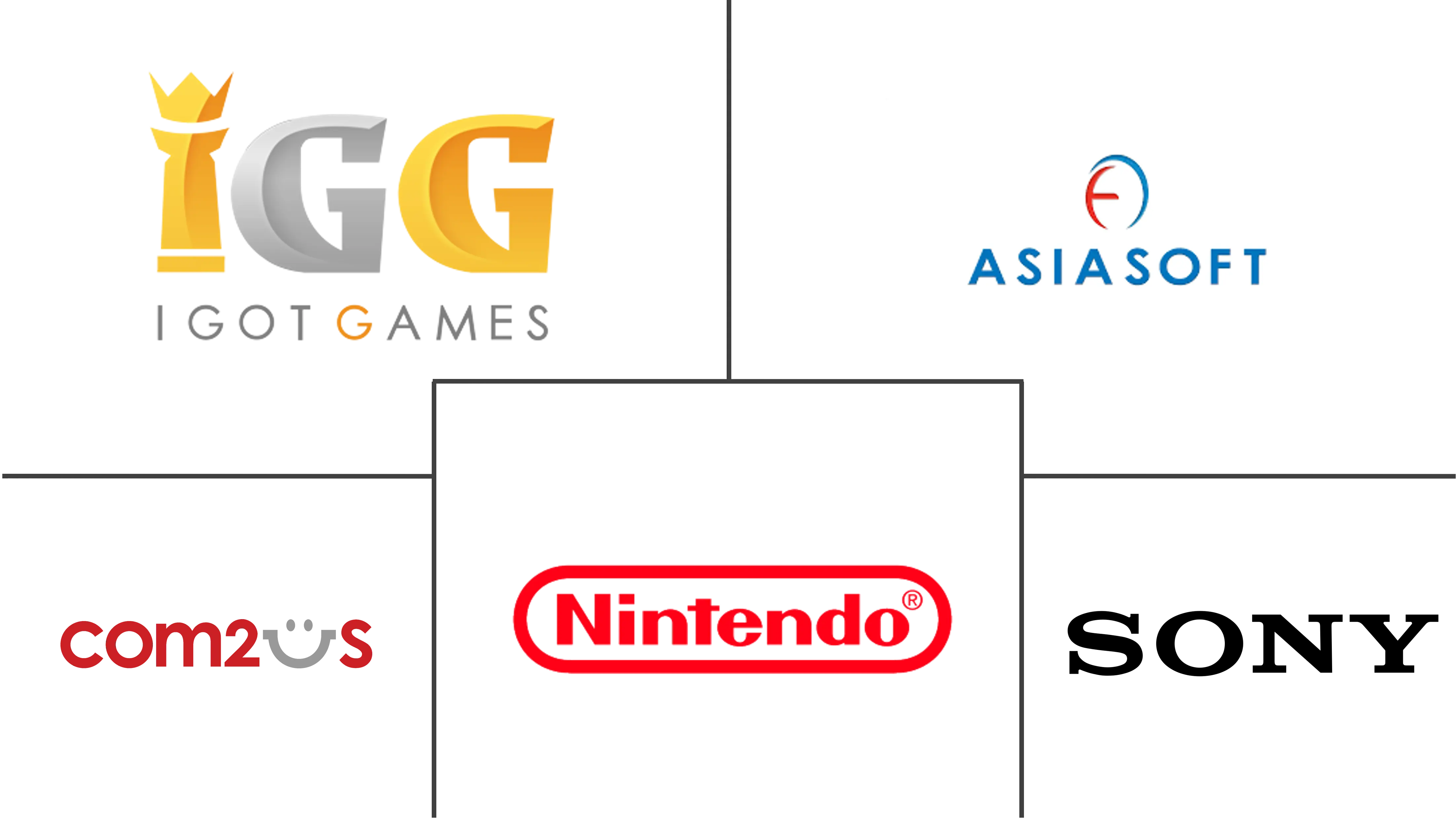Market Size of Southeast Asia Gaming Industry

| Study Period | 2019 - 2029 |
| Base Year For Estimation | 2023 |
| Market Size (2024) | USD 14.80 Billion |
| Market Size (2029) | USD 14.93 Billion |
| CAGR (2024 - 2029) | 0.19 % |
| Market Concentration | Low |
Major Players
*Disclaimer: Major Players sorted in no particular order |
Southeast Asia Gaming Market Analysis
The Southeast Asia Gaming Market size is estimated at USD 14.80 billion in 2024, and is expected to reach USD 14.93 billion by 2029, growing at a CAGR of 0.19% during the forecast period (2024-2029).
The rising popularity of various sports and investments in internet infrastructure are the primary factors driving the market's enormous growth potential.
- The introduction of 5G technology in recent years aided in expanding wireless network infrastructure investments. As a result, the low latency of 5G may enable users to have a significantly more seamless cloud gaming experience. For instance, Southeast Asian operators have announced partnerships worth USD 30 billion (30,000 million) in 5G investment. The previous year, the two major Indonesian operators, Ooredoo and CK Hutchinson, signed a USD 6 billion (6,000 million) agreement for their telecommunications operations. True, Thailand's second-largest telco, announced a merger with DTAC, creating a USD 8.6 billion (8,600 million) company with approximately 51 million customers.
- The growing popularity of e-sports is also boosting the region's game market. E-sports is a video game competition. With increased viewership on online platforms such as Twitch and YouTube, advertising is expected to generate more revenue during the forecast period.
- However, issues such as piracy, laws and regulations, and concerns about fraud during gaming transactions are expected to hamper market growth, serving as a major restraint for the market.
- Through online multiplayer and group chats, video game players can stay in touch with friends and family. During the COVID-19 pandemic, they helped people pass the time and keep in touch with friends and family in a fun way. Unlike other industries, Southeast Asian gaming is experiencing a surge in demand. Influencer partnerships, in-app advertising, innovations, and gaming partnerships drive the industry forward. In the long run, the industry is expected to grow even more.
Southeast Asia Gaming Industry Segmentation
Asia-Pacific holds the largest share globally in the gaming market, while Southeast Asia generates the largest revenue. The online population in Southeast Asia is rapidly rising, mostly due to increased mobile device use. Almost two-thirds of the gaming population in Greater Southeast Asia are engaged in e-sports. Owing to this trend, the region is also becoming the fastest-growing gaming market in the world.
The Southeast Asian gaming market is segmented by platform (PC, console, mobile) and geography (Indonesia, Malaysia, Singapore, Thailand, and the Rest of Southeast Asia). The market sizes and forecasts are provided in terms of value (USD million) for all the above segments.
| Platform | |
| PC | |
| Console | |
| Mobile |
| Geography | |
| Indonesia | |
| Malaysia | |
| Singapore | |
| Thailand | |
| Rest of Southeast Asia |
Southeast Asia Gaming Market Size Summary
The Southeast Asia gaming market is poised for steady growth, driven by the increasing popularity of sports and significant investments in internet infrastructure. The advent of 5G technology has played a crucial role in enhancing wireless network capabilities, offering users a more seamless cloud gaming experience. This technological advancement, coupled with the rising interest in e-sports, has contributed to the market's expansion. Despite challenges such as piracy and regulatory issues, the gaming industry in Southeast Asia continues to thrive, with influencer partnerships and innovations propelling its growth. The COVID-19 pandemic further accelerated demand, as video games became a popular means of social connection and entertainment.
The mobile gaming sector, in particular, has seen remarkable growth due to the widespread availability of free-to-play options and the proliferation of low-cost smartphones. Southeast Asia's urban and rural populations are increasingly engaging with online games, supported by rising internet penetration. Major technology companies are investing heavily in this market, with cloud gaming emerging as a significant opportunity, allowing players to enjoy games without the need for constant hardware upgrades. The competitive landscape is marked by the presence of both small and large players, with strategies focused on product and service innovation, mergers, and acquisitions. This dynamic environment is expected to drive further growth and diversification in the Southeast Asian gaming market.
Southeast Asia Gaming Market Size - Table of Contents
-
1. MARKET DYNAMICS
-
1.1 Market Overview
-
1.2 Industry Value Chain Analysis
-
1.3 Industry Attractiveness - Porter's Five Forces Analysis
-
1.3.1 Bargaining Power of Suppliers
-
1.3.2 Bargaining Power of Consumers
-
1.3.3 Threat of New Entrants
-
1.3.4 Threat of Substitutes
-
1.3.5 Intensity of Competitive Rivalry
-
-
1.4 Market Drivers
-
1.4.1 Increasing Internet Penetration to Boost the Market Growth
-
1.4.2 The rising popularity of smartphones and 5G technology is expected to boost market growth.
-
-
1.5 Market Restraints
-
1.5.1 Users' devices with limited game support may act as a market restraint.
-
-
1.6 Assessment of the Impact of COVID-19 on the Industry
-
-
2. MARKET SEGMENTATION
-
2.1 Platform
-
2.1.1 PC
-
2.1.2 Console
-
2.1.3 Mobile
-
-
2.2 Geography
-
2.2.1 Indonesia
-
2.2.2 Malaysia
-
2.2.3 Singapore
-
2.2.4 Thailand
-
2.2.5 Rest of Southeast Asia
-
-
Southeast Asia Gaming Market Size FAQs
How big is the Southeast Asia Gaming Market?
The Southeast Asia Gaming Market size is expected to reach USD 14.80 billion in 2024 and grow at a CAGR of 0.19% to reach USD 14.93 billion by 2029.
What is the current Southeast Asia Gaming Market size?
In 2024, the Southeast Asia Gaming Market size is expected to reach USD 14.80 billion.

